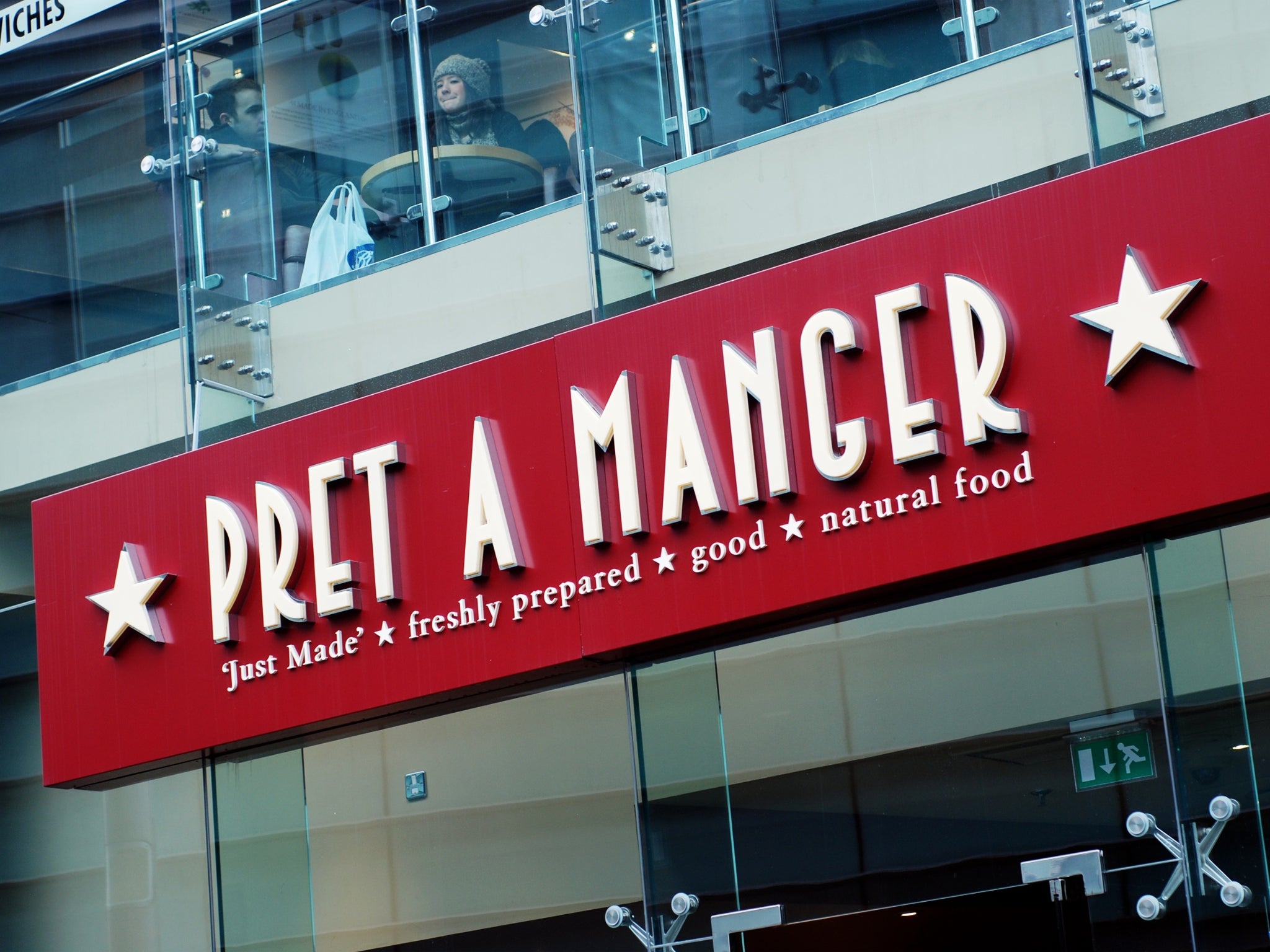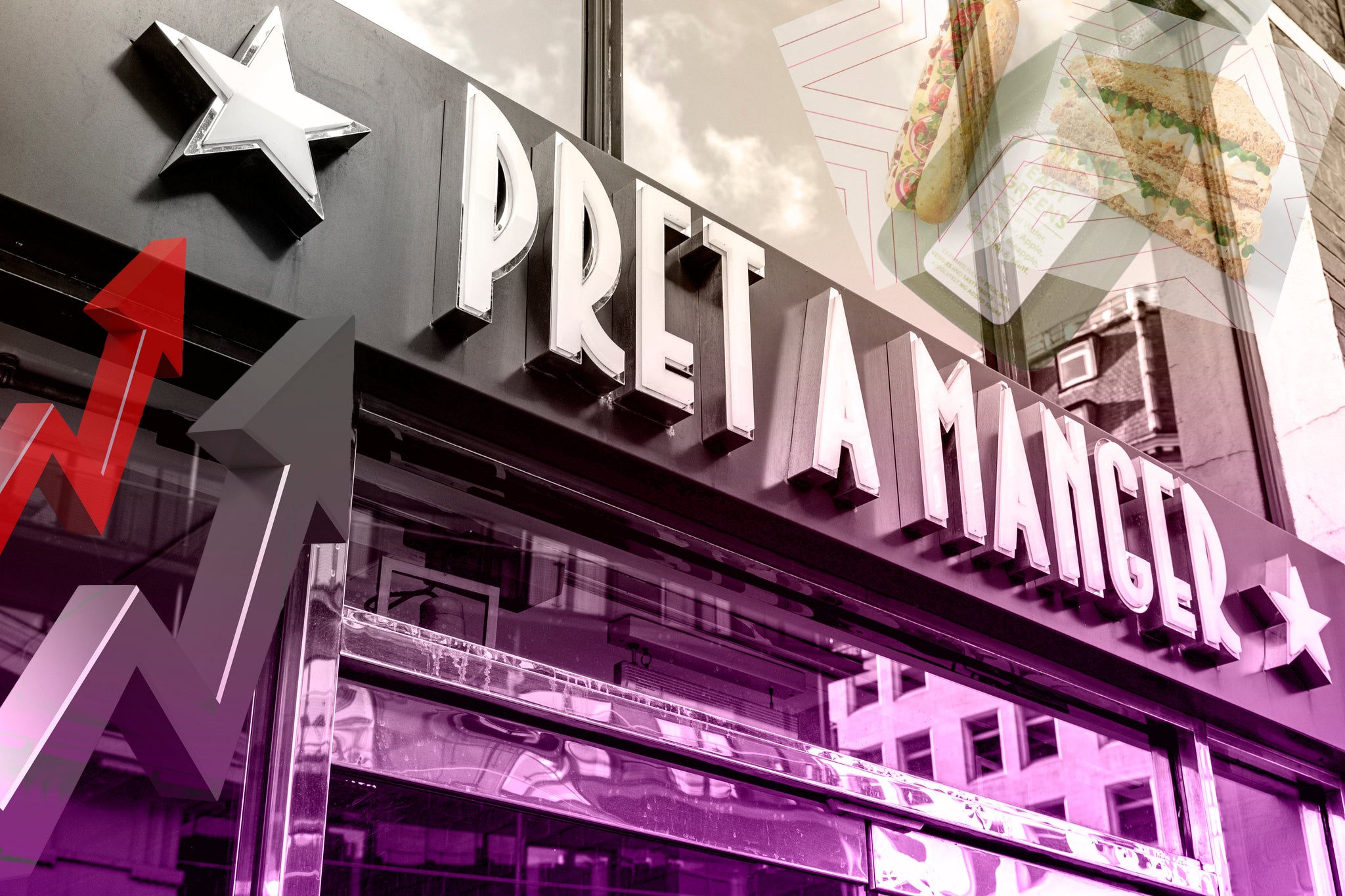Pret is the worst – but the lunchtime juggernaut is too big to stop now
The British public is falling out of love with Pret A Manger, writes Roisin Lanigan. Once an adored bastion of lunch-hour culture, the chain is suffocating under the weight of extortionately priced egg mayo sarnies and overpriced lattes. Depressingly, though, even ‘hyper-pretflation’ won’t stop us eating there

It doesn’t happen often. I’m not proud of it. The last time it happened was really nothing more than an accident, a fluke. There were no other shops around, and I was deeply hungover after a slew of reasonably chaotic Christmas parties. There was nothing else for it: I had to go to Pret. All I wanted, Your Honour, was a can of Coke Zero. For some reason, this cost £1.85, a fact my mind didn’t register until I went to tap my phone to pay. I looked at the Pret cashier. The Pret cashier looked at me. “You can’t be serious,” I said. “I know,” he said. It was the sad denouement to a year of falling out of love with Pret.
I’m not alone in my decision to break up with Pret. Every other week a viral tweet will point us in shock and horror to a sad baguette or an overpriced salad; so much so that “Pretposting” has become a genre of its own. Last month, food writer Tom Parker-Bowles wrote about how the once beloved chain had become unaffordable and unappealing to even the most hardened, palette-challenged city bankers. Cheese and pickle baguettes cost upwards of £7.15, egg mayo sarnies have shot up – at the time of writing, and presumably it will be worse now – by a frankly Kafkaesque 72 per cent since August 2020, and there’s still that compulsory “dine in” surcharge: a 20 per cent VAT for the pleasure of staring at a maroon sea of ripped off commuters eating sad mac and cheeses. Green juice, bizarrely, is a fiver.
“Pret used to offer value and quality,” writes Parker-Bowles. “Now, it does neither. What was once the hero of the high street is in danger of becoming a sandwich basket case.”
It wasn’t always like this. Pret A Manger was once a PR darling, a 40-year-old bastion of British lunch hour culture, second only to the humble Tesco meal deal. During the pandemic, their five-coffee-a-day subscription service became unexpectedly popular, presumably because people had nowhere else to go and nothing else to do except walk around, six feet apart, carrying desultory takeaway coffees. But then the world pivoted on its axis again; the WFH utopia ended and we funnelled ourselves back into offices. Subscription services also rose in price across the board and suddenly every chain, brand and service was competing against the price of commuting normally, living normally and socialising normally again. Of course, the Pret subscription had thrived when all it had to compete with was painting by numbers and loo roll stockpiling.
And now, three years on, even Pret’s hero product, that pandemic love story, their monthly subscription service, can’t save them. Although “little treat” culture is still thriving, Pret hardly feels like a treat. It’s too ubiquitous, and it can’t match the delights of an artisan matcha or boba tea. This year the chain announced a jump in its subscription price of 20 per cent, increasing from £25 to £30 a month – while adding a paltry 10 per cent discount on all food to the existing coffee deal. The price bump accounted for, according to Pret’s apologetic reasoning, an extra £1 to cover ingredient prices, £2 to cover staff wages and £2 to cover energy costs, allegedly. The Times called that logic “a joke”.
Perhaps we’re all being a little harsh on Pret, though. After all, in a year dominated by inflation and a spiralling cost of living crisis, it’s true that everything costs more, all the time. But the problem people have with Pret’s pricing, and with Pret generally, is that even when they do break down their decisions in an attempt at transparency, it comes across as inauthentic. We as consumers seem to be making a distinction, every time we trudge into that burgundy pit of terrible baguettes: there’s inflation, and then there’s Pret pricing. Earlier this year, the Financial Times even gave the practice the dubious honour of its own newly minted term; they called it “hyper-pretflation”. Every time the chain sneakily adds an extra 5p to the cost of those aforementioned terrible baguettes they get one step closer to cementing their reputation as the UK high street’s equivalent to the Weimar Republic.
Pret is valiantly attempting to hold back the tide of that PR backlash. In September, Guy Meakin, the chain’s shops and franchise director, defended its price hikes after being accused – unsurprisingly – of rampant profiteering during the cost of living crisis by both The Times and The Sun. “Prices are going up”, he said, “so unfortunately we are having to pass our prices through to customers from time to time.” He spoke of the need to be both “mindful” and “competitive” at the same time. “We have more price points than we’ve ever had because of our different types of formats, and we need to hold ourselves to account on that.”
As a statement, it’s the equivalent of an apologetic, half-arsed shrug. It felt particularly unconvincing, too, given that 2023 was the first year Pret announced profits since 2018. Those numbers weren’t exactly negligible either; gross profits, in fact, were up 83 per cent (The Times reported even higher, at 89 per cent). To reiterate, the price of an egg mayo sandwich – the saddest of all the sandwich universe – is up 72 per cent since 2020, compared to CPI inflation of 20 per cent over the same period.

But while the cold hard numbers don’t lie, the negative PR continues to circulate. After a year of fighting back on profiteering claims, in the past month, they’ve found themselves the centre of an ongoing boycott of Israeli goods amid the country’s ongoing war against Hamas and military bombardment of Gaza. Branded “Pret A-Partheid”, the chain was criticised for its plans to open more than 40 branches across Israel in the next decade. Perhaps wisely, given the lacklustre response Meakin had on the relatively uncontroversial topic of price hikes, Pret have yet to respond to the boycott, but it’s a grim end to a grim year, one in which, wherever you stand, we’ve fallen out of love.
But does it really matter that we have? Whatever Pret’s political affiliations – can a latte have a political affiliation? Is this brand my friend? – and whatever ridiculous heights their prices reach, the sad fact is that convenience is king to us, the lazy, frazzled, hungover commuter class. There will always be an occasion where Pret is what’s closest and easiest. It sometimes feels, walking down any British high street, that there are more Prets than there are people.
Increasingly, Pret A Manger seems like a juggernaut that’s too big to fail. Pret just rolled out their subscription service in France. They want to “accelerate their US expansion”. Northern Ireland’s first Pret opened this month. They shouldn’t have bothered. The sad reality could be that the inexorable force of Pret A Manger will never go away, however much we secretly resent it. Pret will remain blanketed across our towns and cities, a mahogany nightmare of egg mayos costing upwards of £30, and we’ll all simply accept it, because who can be bothered to walk eight minutes down the road for a Tesco meal deal that now costs £4 rather than £3? We can hate it but we can’t escape it. It’s Pret’s world now; we just live in it.
Join our commenting forum
Join thought-provoking conversations, follow other Independent readers and see their replies
Comments